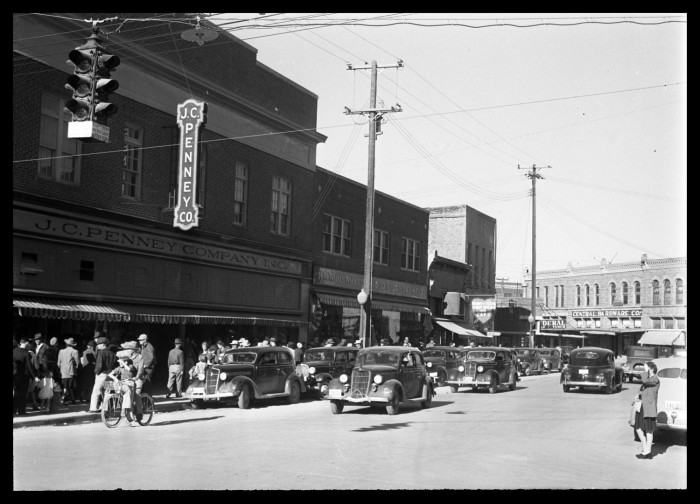
It was Sunday and we drove to Early on that beautiful Central Texas day. It was clear with blue skies and some light puffy clouds, and the day was pleasant to look at so long as you were in the air conditioning and not out in it for very long. Sunday is one of the only days we leave downtown. Once we’re up and going on Sunday sometimes we drive out to Early and go to Butterbeans, which is an antique/junk store and that’s what we were doing on this Sunday. After Butterbeans we drive the handful of miles back to Brownwood and we go to Ricochet, which is another antique shop we like.
We like Hey June and Junk and Disorderly and a few others, but they aren’t open on Sunday. If you’re in Coleman and it’s not Sunday, go see my friend Wes at Bonneville and you’ll see what I’m talking about in this column. Time travel and nostalgia.
A good, packed shop like Butterbeans or Ricochet is a time travel museum you don’t have to pay to go to.
I’ve written a lot of time travel stories (as many of you know,) and it is one of my favorite genres of fiction. If you’ve read my time travel literature, you will be familiar with what I call “Finneyesque” time travel – made famous by the great author Jack Finney in his stories. Homage was paid to Finney by use of this method in the cult film Somewhere in Time (1980) starring Christopher Reeve and Jane Seymour. The gist of Finneyesque time travel is this…
“Finneyesque” time travel is based loosely on Einstein’s comments and theories – the idea that all time exists simultaneously and that, as Einstein said, “the distinction between the past, present and future is only a stubbornly persistent illusion.” We experience time as a man does who is in a boat sailing down a lazy river and he sails past a beautiful little tree, and now it is behind him and now… back there… around the bend… and it is in his past. But Einstein said that the tree is not gone. It is still back there. If one could get off the boat and walk back, he would find that tree still standing there much as he remembered it. To our perceptions, time flows forward and what is behind us is gone forever, but that is because we are tied to our “now” by a million tendrils – strings of the persistent now – that connect us with our time as it moves forward… to us. An Apple watch. Facebook. Persistently stubborn social media. These things tie us like shackles to the “now.”
The Tendrils of the Now
Jack Finney wrote of the tendrils of the now – the little realities that tie us to our present time moving forward, and he also wrote of the heart tendrils of the “back then.” Nostalgia.
Nostalgia is a form of physical pain, and it is one of the only instances where reasonable/sane people actually seek out a form of physical pain. We’ll get to that. Stick with me.
Finneyesque time travel worked like this: In most of his stories (and in many of mine,) IF the protagonist is engrossed or surrounded in so much accurate detail of the period he wants to visit, and IF the protagonist can separate himself from the present (mentally break the tendrils of the stubbornly persistent now,) and IF the protagonist has the ability to mentally inhabit that projected time period, then time travel becomes possible.
Possible, but not likely.
Like I said, stick with me. We’re going somewhere (or somewhen.)
Not everyone can do it. Not everyone can sever all of the minuscule threads of the “now” that link us to the present. The mind has to be wholly given over to the “then” of the period being sought after, and this involves absorption into the microscopic minutia of the past. Even down to the buttons and coins and dress and news and environment. Even if they were to be completely saturated in the target time period, most people could not actually time travel. They cannot break from the present.
In Finney’s stories, if your mind can be inundated with the elements from the time you want to travel to, and if the tendrils tying you to the “now” can be thrown off, and if the creative mind has the ability to do it (like in reading a great book,) then you can actually travel to that time (Read my stories All I Can Be, or The Santa Anna Gold, or God Bless This Prison. All of these use Finneyesque time travel as the mechanism.)
So… it’s time to travel. It’s Sunday and we’re in an antique store and I’m overcome with nostalgia. When I was young, going through an antique store or a junkyard I felt curiosity, but never nostalgia. The old things were interesting, remnants of some place and time I’d never experienced. I had no connection to them. But now, many of the things I see cut me. There is the butter dish my grandmother had. Over here is the Tupperware we used (orange and avocado green.) I remember this record album and now I’m in my grandmother’s apartment in Dayton, Ohio and I am watching that record revolve on the turntable and my grandmother is calling for me to turn off the record and come watch Hee-Haw. These are the things of my life and I’m connected to the time when these things were new and I know that time and I feel it. I was there.
Real nostalgia is an “open wound,” pain, but blended with something else. A knowledge and embracing of the passing of life, like a friend grown old or a place you once loved torn down and now vacant. It is a reminder that we’ve loved a moving target, and that what we thought was true is still back there, around the bend of the river. And that inevitability is a patient opponent, not given to sentimentality.
Reading a book is the time travel that is possible for some percentage of the population that still reads. Some people can do it. They leave themselves back in the stubbornly persistent now and in their hearts and minds they can travel and live a thousand different lives, or just an old one they remember firsthand.
Memory is a powerful thing.
We have more control over our memories than we think, to make them good or to make them bad. Our mind makes filters, like Instagram, but most people today want to use memories as a tool to validate the now, which usually involves coloring the past dark. To swim in a false story. (Don’t do it. Resist it. If you don’t, future you will blacken your now and there is no end to that cycle of darkness. Nostalgia is better than wound licking or dark, cynical revisionism.)
And here (finally) is the point.
Revitalization is, by definition, an act of nostalgia. There is more to this story than meets the eye, and I plan on writing more about it, but revitalization literally means “re-life,” that is, bringing life back to a thing or a place. In a religious or spiritual sense, we use the term “revival,” which means the same thing.
Urban revitalization is a return to something that was lost.
Here is a very quick and cursory tutorial of our past…
The term City comes from the word Citadel. In antiquity, Citadels were fortified areas, usually surrounded by walls, where people could go when enemy armies approached. Eventually, because they were safer, people traveled to citadels to trade. They came from far away to find a place – walkable – where they could get goods and services.
Brownwood was such a place. Wagon yards were all over downtown and people parked their wagons there for the night and waited for the next day to trade and barter and socialize and then they loaded their wagons and went back to the farm or ranch.
Wooden buildings gave way to brick and stone.
Eventually, people moved to cities and lived there. “Downtown” was a walkable area where you could go from shop to shop, or to a restaurant, and you didn’t have to get into a car every time you wanted to go somewhere else. There was something to it that salved the ache we all have for community and peace and safety. It was the universal Mayberry.
Strip shopping centers in the suburbs killed downtown, but they were a weak facsimile. People got tired of having to drive to downtown, so they built shopping centers – little sheetrock buildings with glass fronts and no personality and built to fit our plastic lives in the persistent, disposable now.
The malls killed the strip shopping centers… mostly. People didn’t know it, but they had nostalgia for the old walkable downtown. So, modern man built them a pretend downtown inside a massive building. They could park and walk from shop to shop and maybe to a restaurant too. Go see a movie. Get a drink. It was all very artificial. Fakeberry. But, it was designed to anesthetize the nostalgia and kill the pain of something communal we’d lost.
Urban sprawl and ever denser suburbs killed the malls and shopping “areas” became a thing. Every ten miles you’d see the same stores/restaurants duplicated again and again. McDonald’s, Starbucks, Barnes and Noble, Pier One. Plastic life. Zeroxberry.
Then online killed the malls and the mom-and-pop shops, but online made no allowances for nostalgia at all. Sure, you can get it all with free shipping and a money-back guarantee, but you can’t kill the pain of communal loss of connection with next-day shipping. A walkable community is something man desires on a very primal level.
I don’t know… maybe some people like the plastic life. But that doesn’t change inevitability.
It was all inevitable, you see? Small town downtown revitalization was always going to happen. We’re all looking or Mayberry at some level. Nostalgia demands it. It is a form of time travel. Old buildings are made new and re-inhabited. They call back to us and want to live. Crumbling brick fortified and stone walls made backdrops for new and exciting opportunities. Café life and mom and pop shops. Sipping and Strolling. Entrepreneurs making a go at it.
It’s Sunday and we’re walking through the past and we buy a few things here and there. Stimulate the economy and whatnot. I buy a few vinyl records and we drive back to the apartment and I put one on the turntable and my mind drifts. I can travel. Not every can, but I can.
Maybe you can too.
***
Michael Bunker is a local columnist for BrownwoodNews.com whose columns appear periodically on the website.
